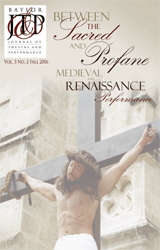
Between the Sacred and Profane: Medieval and Renaissance Performance
Fall 2006
Letter From the Editor
Editorial: Reclaiming the “Sacred” from the “Profane”
K. Sarah-Jane Murray & Sinda K. Vanderpool
Feature: “I Was Never Bard ‘Ere”: Creation and Charity in the Wakefield Play of Noah
Veronica Alfano
Feature: The Depiction of Jews in the Carnival Plays and Comedies of Hans Folz and Hans Sachs in Early Modern Nuremberg
John D. Martin
Abstract: Martin argues that these dramatic works go beyond Bakhtin’s understanding of the carnivalesque as a “safety valve” in an attempt (not always successfully) to influence popular conceptions and effect actual social and political change, primarily for the Jews living in Nuremberg. Folz’s late work supported the expulsion of the Jews from the city, while Sachs uses the stage to defend Reformation Christianity as the true path, above Catholicism and Judaism. Both playwrights’ works contains theological content, thus illuminating how early modern German Christians and Jews interpreted similar religious texts. Together, their work also trace changes in stage representations of the Jews.
Feature: The Actor’s Carnal Eye: A Contemporary Staging of the Digby Mary Magdalene
Peter Cockett
Abstract: Crockett chronicles his experience with the production of the Digby Mary Magdalene, with particular attention to the performance of the lead role. Comparing the acts of reading and of producing this play, he explains two different ways of knowing and the use of affective imagination. He examines this process in relation to contemporary practices and affective piety via the writings of medieval mystics and the work of theorist/director Jerzy Grotowski
Richard Hardin
Highlight: Shakespeare’s Twelfth Night at the Armstrong Browning Library, A Performance Report Stephen Prickett Book & Performance Reviews:
- Anna Andes-Theatre and Society in the Classical World, Ruth Scodel
- Peter Civetta-Death by Drama and other Medieval Urban Legends, Jody Enders
- Elizabeth Williamson-Shakespeare’s Religious Allusiveness: Its Play and Tolerance, Maurice Hunt
- William Grange-The Longing for Myth in Germany,George S. Williamson
- Stacey Connelly-“Via Crucis” at San Fernando Cathedral of San Antonio, Tx
- Steve Earnest-“MacBeth” at the Old Globe, San Diego, CA
- Eric Thibodeaux-Thompson-“Nathan the Wise” at Chicago Festival of the Arts, Chicago, IL
